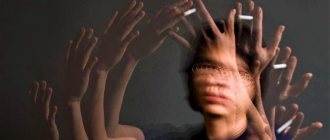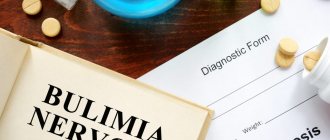Schizophrenia - a severe mental illness with a chronic course. It most often develops at a young age: after 20 years in boys and after 26 years in girls. But there are often cases when this disease occurs in both children and adolescents. Symptoms and signs of schizophrenia in adolescents are closely related to the characteristics and degree of neglect of the disease, the personality characteristics of the patient and his age.
Features of the course of the disease
Adolescent schizophrenia is associated with the development of pathologies in a child that cause deviations in emotional and mental health, and also distort, in connection with this, an adequate perception of the surrounding reality. There is a similarity between the primary signs of schizophrenia and psychopathy:
- practice of various sexual deviations;
- aggressive behavior and disobedience;
- refusal to attend school classes.
Among the pronounced symptoms of schizophrenia in adolescents, pronounced autism, decreased physical and mental activity, and an explosive build-up of negative emotions are usually identified. Persecution mania and hallucinations, on the contrary, are practically uncharacteristic for adolescents.
Stages
The disease in adolescents, as in adults, develops over several stages.
The first stage is called mastery. During this period, the manifestation of the disease occurs. The mastery stage is characterized by the fact that the patient can feel pathological phenomena, for example, hallucinatory voices, but does not understand their origin.
The second stage is called adaptation. At the adaptation stage, the patient’s psyche adapts to the disease. The patient may be aware of the fact of his illness.
The third stage, the final stage, is degradation. At the third stage, there is a gradual extinction of all mental and intellectual characteristics of a person.
What types of diseases occur?
If you look in more detail, there are several types of the disease, each of which has its own characteristics of the course and rate of progression, so, in adolescents, schizophrenia occurs:
- Continuously flowing. It begins in childhood, but after the onset of puberty it acquires a constant course and pronounced signs of mental abnormality.
- Paranoid. Sometimes hallucinatory-delusional. It occurs in the form of changes in mood and the development of delusional ideas.
- Recurrent.
- Acute puberty.
Causes
Let's list the main ones:
- The cause of childhood and adolescent schizophrenia lies in genetic disorders. Mutations that occur in the DNA of patients are not observed in healthy children. Previously, medicine did not address the issue of genetics. Currently, a hereditary factor is accepted.
- The causes may also be disturbances in the activity of brain cells. This diagnosis occurs when there is a deficiency of acetyl-histone bonds.
- Also, the cause of the disease can be an imbalance of certain substances in the child’s body, which can lead to a failure in the metabolism of protein and carbohydrate compounds.
- There are also reasons that lie in late pregnancy, prolonged exposure to extreme life situations, violence against children, and frequent scandals in the home. The following can have a detrimental effect on the psyche: divorce of parents, viral infections transmitted in the womb, her fasting during pregnancy.
- The reason may lie in childhood drug addiction and the use of psychotropic substances.
How the disorder manifests itself
Schizophrenia in adolescents takes a number of forms and flows from one stage to another. Each of them has certain characteristics:
- Paranoia. The person has hallucinations and becomes delusional. This means that the teenager sees and hears things that other people cannot see or hear.
- Catatonia. Sudden change in activity. Periods of energy are replaced by complete apathy.
- Hebephrenia. Most often found in teenagers. A person becomes immature and behaves like a child.
- Without a pronounced form. A schizophrenic demonstrates a combination of several forms of the disease.
- Residual. Characterized by a lack of empathy and emotional coldness. A person strives to be alone.
- Simple. Combines a number of characteristics of previous forms. Often occurs in adolescence. The person is apathetic, has no aspirations, hobbies, does not show affection for other people, and is infantile.
Heboid syndrome
With heboid syndrome, there is a distortion of the personal qualities of a teenager suffering from schizophrenia. The features of this condition in most situations can be seen at an early age.
The child’s general behavior is based on features of a high interest in cruelty:
- manifestation of violent actions towards animals,
- toys,
- aggressive behavior with younger children and parents,
- interest in films with murders.
Characteristic signs of the syndrome are also increased sensitivity to insults , which is combined with indifference and aggressive behavior towards relatives. The features of a ruthless attitude towards weak family members in adolescence are especially pronounced.
At the time of sexual development, heboid syndrome can express in adolescents a manner of enlightenment, the emergence of a craving for abstract thinking about the world and its problems. Philosophical reflections elevate a teenager with schizophrenia above his peers and make his behavior indifferent towards other people.
The presence of the disorder increases the risk of immoral behavior . The actions of a teenager can express increased sexuality in a perverted form; alcohol and drug addiction, alienation from home, and far-fetched motives for seclusion in an unfavorable environment may arise.
Taking psychotropic drugs can contribute to the commission of illegal actions of varying severity. If such a condition occurs, it is recommended to isolate the patient in a hospital for round-the-clock monitoring by specialists until the adverse factors are eliminated.
In cases of schizophrenia, heboid syndrome is difficult to treat (if we compare the syndrome with a disorder in psychosis or pathology), but a correctly selected approach combined with therapy methods makes it possible to achieve a positive result in treatment.
Antipsychotic drugs must be taken on a regular, systematic basis, otherwise a relapse will inevitably occur, which will have a negative impact on treatment.
The meaning of the word schizophrenia
Symptoms
The first signs of schizophrenia in a teenager also have their own characteristic differences; the older the age, the more complex the course of the disease. A 13-year-old teenager may experience hallucinations, delusional ideas, some of the children become completely uncontrollable and pose a danger to people around them. Many parents, not wanting to look for the reason for such changes, attribute what is happening to a transition period.
The following symptoms should raise alarm:
- The teenager exhibits clown behavior, fools around a lot, and gets overly emotional.
- It is difficult to carry on a conversation, words are confused, thoughts become inconsistent.
- In the imagination of a teenager, aggression towards others can be seen, this can be seen in drawings, games, etc.
- Shows excessive narcissism and selfishness.
- Over time, the child becomes detached, loses interest in communicating with loved ones, and cruelty appears.
- Often a teenager has a meaningless conversation with himself.
- Sitting in one position for a long time, or, conversely, showing hyperactivity.
- A child may begin to take an active interest in books on science fiction themes, study the processes of the universe, and read encyclopedias and reference books.
- The teenager’s games are of the same type and cyclical; he plays out the same situation several times.
Types of disorders found in children
Most often, children at an early age are diagnosed with delayed psycho-speech development. Such disorders can take various forms; very often they develop in the absence of significant motor dysfunction. The child rolls over onto his back for the first time, sits up and walks as expected.
Delayed speech development can be diagnosed at the age of about 2.5 – 3 years. This disorder in rare cases is an independent diagnosis; most often its presence is only a symptom of more serious mental disorders.
There is now a sharp increase in the detection of autism in children. Classic signs of this disorder are:
- excessive isolation;
- constant desire to be alone;
- reluctance to build communication with other people;
- disturbances in speech development, with a tendency to repeat phrases, erroneous use of pronouns, monotonous and repeated repetition of the same words;
- mannerism and stereotypy;
- deliberately inflicting pain on oneself. Children bite themselves, pinch themselves, pull out hair, etc.
At the same time, sick children have excellent memory and a desire for order. But recently, autism in its pure form is rare. This disorder is accompanied by severe developmental delays, mental retardation and behavioral disorders with a tendency towards heteroaggression.
The most common mental disorders in children also include hyperactivity, attention deficit disorder and other behavioral disorders. In some cases, such disorders are compensated with maturity, but, more often than not, ignoring the problem in early childhood leads to more severe forms of the disease in adolescence.
With timely contact with a psychotherapist, these types of mental disorders can be successfully corrected. For example, the popular singer and actor Justin Timberlake suffered from attention deficit disorder as a child. The parents took the boy to a specialist, and he helped solve the problem. Now, although Justin is still not always able to concentrate on performing monotonous operations, nevertheless, he has become a successful, popular person, and an excellent family man.
Mental retardation is most often diagnosed in childhood. As a rule, this diagnosis can be identified only after the child reaches 3 years of age. Retardation can have different forms; with a mild or moderate degree of this disorder, it is possible to achieve social adaptation of patients. In severe forms of mental retardation, patients need constant care and control from loved ones throughout their lives.
In some cases, children may have trouble developing one skill. For example, reading, counting, writing or movement functions. This type of disorder should not be confused with mental retardation, which is characterized by a uniform lag in all indicators. To eliminate these violations, pedagogical methods are used to smooth out the existing lag. With timely correction of such disorders, it is possible to significantly improve the patient’s condition as he grows older.
Some mental disorders in childhood/adolescence are difficult to diagnose and are often confused with an adolescent crisis. This is schizophrenia, as well as other disorders similar to it. In such conditions, there is a disturbance in thought processes and a gross change in personality characteristics. If such disorders are not identified at an early stage and timely treatment is not started, their course worsens in adulthood.
The first signs of the disease
Specific symptoms of schizophrenia are disturbances in thinking and perception, delusional deformation of thinking, and the presence of hallucinatory syndrome.
The appearance of the following features in his everyday behavior can help to suspect the presence of a disease in a teenager:
- isolation;
- detachment;
- unusual silence;
- isolation from others;
- difficulties in communicating with peers;
- sudden mood swings.
Particular caution is required in cases with the persistent presence of these first symptoms of the disease in the presence of a burdened family history.
Similar signs characterize adolescence in healthy children. The pathological situation is characterized by the sudden appearance and stable existence of this set of symptoms in combination with specific signs of the disease.
Causes of depression in children and adolescents:
Depression in a child never occurs out of nowhere. There are always prerequisites for such a state. Most likely, the teenager was faced with a stressful situation, and due to his age, was unable to properly accept and survive it. And this is quite enough for a fragile child’s psyche.
The main reasons include:
1. Hormonal changes are a “turbulent” and lengthy process. The maturation of the reproductive system is accompanied by high emotional stress: irritation, melancholy or increased anxiety. As a rule, this period passes after 2-4 years. During this time, accumulated stress can easily develop into a serious disorder.
2. The realities of the adult world - he comes to understand that the world that he saw through children's eyes is not so kind and cloudless, but is full of cruelty and injustice.
3. Youthful maximalism - a teenager feels that he is being ignored, not seen and not noticed. Everything is divided into black and white, bad and good. Against this background, conflicts arise with parents and teachers.
4. Family conflicts - children react sharply to quarrels between parents, have a hard time with divorce or a difficult financial situation. It’s hard if he constantly hears criticism of himself or parents’ dissatisfaction related to poor performance at school.
5. Lack of friends. The most important thing for a teenager is communication with peers, a communication environment, and the opportunity to share common interests with friends. In adolescence, emotional emancipation from parents occurs: if previously the child shared his experiences with his parents, now he can close himself off and not talk about the events of the day and his experiences
In general, this is normal for a teenager, but it is important to find a place where this exchange of emotions can take place. Emotional contact
a teenager is looking for connections with peers, and if such contact was not found, there was no acceptance in the team, no establishment of friendships - for a teenager this is very painful and traumatic. He feels unnecessary and unsuccessful.
6. “Unideal” appearance – teenagers tend to worry that they don’t look like everyone else, are overweight (in their opinion), or that skin problems will turn the whole world against them. Failure to meet the notorious “beauty standards” or the standards accepted in a particular group (for example, it is necessary to be athletic or dress in branded clothes) can result in a teenager being ridiculed by the group, low self-esteem, anorexia and, ultimately, depression.
7. Frequent moves - separation from the established team and its usual comfort zone unsettles you. Having arrived in a new place, a teenager faces difficulties in communicating and creating new connections, which of course affects his condition.
8. Bullying at school - teenagers often show unjustified cruelty, which leaves its mark on the psyche.
9. Addiction to the Internet and computer games - in the virtual world it is easy and simple to be successful, in the real world it is much more difficult.
10. Increased loads - some children have a hard time with the school curriculum. And many parents insist on attending additional classes and clubs, believing that this is only beneficial. This rhythm of life creates an additional stressful situation that not everyone can handle.
11. Unrequited love or the first unsuccessful sexual experience - experiences in such a state take a lot of energy, and there is often no one and nowhere to share experiences and receive support.
The main danger of schizophrenia in adolescents
Schizophrenia in adolescents is dangerous because its symptoms often resemble an adolescent crisis; the slow descent into it can take several years before others suspect the disease. At first, a teenager may be tormented by suicidal thoughts and distorted perceptions of sensations, followed by a gradual withdrawal from the world and from himself. This happens almost unnoticed by relatives, who think that a decrease in the liveliness of character and frequent thoughtfulness are signs of the child growing up. The former love for parents and kindness disappears, causeless laughter is replaced by the same tears, a desire for loneliness, gloominess and isolation appear. All this is attributed to adolescence and does not particularly alarm loved ones.
Stages of development of schizophrenia in adolescents
There are several stages of development of the disease in adolescent children.
First stage.
The first signs of schizophrenia in adolescents are observed at the age of 12-15 years. They are expressed:
- depression;
- sharpening of character traits;
- the presence of phobias, especially about one’s appearance;
- depersonalization – the child feels a change in the perception of his own “I”;
- difficulty in establishing contacts with others.
Active, manifest stage.
This stage corresponds to the age of 16-20 years . All of the above signs of schizophrenia, characteristic of a 15-year-old teenager, begin to progress rapidly. Now they are expressed more clearly and sharply. It is at this stage that the first visions, hallucinations, delusional and obsessive ideas, and hypochondria appear. At the same time, mental abilities continue to deteriorate - thinking becomes inhibited, speech, memory and concentration disorders are observed.
Stage of recovery, recovery.
This stage corresponds to the age of 20-25 years . Thanks to effective therapy and an individually developed treatment regimen, it is possible to get rid of most productive symptoms in the form of delirium , hallucinations, increased excitability, and also to compensate for cognitive functions. The patient can re-adapt to society, re-enter the university and continue his studies.
Residual, preventive period.
Some patients may retain residual effects of negative symptoms - aloofness and detachment from the outside world, isolation, infantilism. The weak expression of these signs will not be an obstacle to leading a normal, fulfilling life.
Is schizophrenia inherited?
There are many European studies that indicate the presence of hereditary transmission of schizophrenia. Despite repeated examinations of schizophrenics, experts have not been able to identify special genes that provoke the disease in children, adolescents and adults.
In the study of large groups of patients whose parents suffered from psychosis, various pathological genes were found, but it was not possible to establish their relationship with the occurrence of schizophrenic disorder.
If you analyze the literary sources, you can find descriptions of various types of pathological genes found in schizophrenia, but it is impossible to reliably indicate the activity of certain genetic factors in one form or another of schizophrenia.
Causes
Research to establish the causes of schizophrenia is still underway, and it is impossible to say for sure what specific preconditions influence its occurrence, but long-term observation of patients and the study of their DNA have made it possible to identify several reasons:
- Genetic features. About 40% of schizophrenics have relatives with a history of this or other mental disorders. If a close relative of a child has schizophrenia, the chance that it will be passed on to him is 10%.
- Unfavorable social and living conditions and the specifics of upbringing. Children growing up in families of alcoholics and drug addicts are more likely to have serious mental health problems.
The atmosphere in the family is also of great importance. The most dangerous in terms of the likelihood of developing schizophrenia in children are families where parents are toxic to one degree or another. If parents beat, humiliate, insult or ignore their children, use them in criminal activities, try to control them excessively, and demand unconditional obedience from them, then such a family is definitely toxic. - Strong psycho-emotional shocks. Depending on the personal characteristics of the child, many events can act as a strong shock, even those that for most children will not be traumatic. Examples: death of relatives, friends, pets, getting into an accident, an acute episode associated with public humiliation, rape or other sexual assault, beatings.
- Drug addiction, alcoholism. A teenager is extremely susceptible to the influence of peers and other people who surround him, while parents are rarely included in this circle of trust. If a child finds himself in an unfavorable environment, he may develop an alcohol or drug addiction. Hallucinogenic drugs especially increase the likelihood of developing schizophrenia.
- Disorders that arise during the formation of the fetus and during childbirth. Infectious diseases suffered during pregnancy (hepatitis, measles, cytomegalovirus) increase the risk of developing disorders in the child’s brain. The likelihood also increases if the mother took drugs during pregnancy that negatively affect the fetus, consumed large amounts of alcohol, or was exposed to toxic substances, including drugs.
- Schizoid personality type. Children with this accentuation are withdrawn, seek to isolate themselves from others, and often report that they are not interested in communicating with them. They also have difficulty understanding other people's emotional experiences. Immersed in fantasies and hobbies, taciturn.
Also at risk are teenagers who:
- They live in large cities. Urban residents suffer from schizophrenia and other mental illnesses much more often than rural residents. Perhaps this is due to the overly intense, stressful rhythm of life in cities.
- They belong to the male gender. On average, men develop schizophrenia earlier than women, so most teenagers with this disease are boys.
But at the same time, schizophrenia can develop with equal probability in a person of either sex, and if you take a random group of people over 35 years old, among them there will be approximately the same number of schizophrenics of both sexes. - Born in winter or spring. Researchers have not yet found an explanation for this.
However, even a coincidence on several points does not guarantee that the child will develop schizophrenia.
About the causes of schizophrenia in children and adolescents in this video:
Hallucinatory syndrome
The manifestation of pathology can be varied: hallucinations can be auditory, visual, gustatory, olfactory, tactile. The most common variant is auditory, visual is somewhat less common, and other varieties appear in rare cases.
Auditory hallucinations involve the perception of non-existent voices or other sounds. Typical options include the sound of dripping water and the creaking of a door. The sounds are intrusive and irritate the patient. The voices heard by the patient may be talking to each other, or it may be one voice communicating with the patient.
Rave
Hallucinations give rise to the next symptom - delusion. It manifests itself in the form of the emergence of various awkward ideas, conclusions, uncoherent speech, and fragments of phrases. There are many types of delirium; the most common types of delirium observed are:
- grandeur, when the patient exalts himself above others;
- influence, in this case the teenager believes that some higher forces are influencing him and his thoughts, reading them;
- persecution, the patient is sure that they are watching him and want to harm him, for example, a neighbor from the eighth floor is a special agent or an alien and must kill him;
- physical disability. Painfully attributes non-existent deformities to himself, for example, a huge nose, one leg shorter than the other, etc.
Manifestation of delirium and its varieties
The manifestation of delirium is determined by a complete or partial disorder of thinking, which cannot be corrected externally. The patient adheres to ideas that do not correspond to reality.
- Delusions of grandeur - exaltation of one's personal significance, qualities, achievements over the entire society.
- Delusion of influence is the patient’s painful belief that his actions and emotions are influenced by unknown forces.
- Delusion of persecution is the patient’s unfounded belief that a person or group of people is watching him, trying to cause harm.
- Delusion of physical disability is a belief in an imaginary non-existent defect; the teenager feels like an incomplete person.
- Unsystematic delirium - destruction of the logical chain of constructing information; the patient may speak in fragments of phrases or use incoherent words that are not related to what is happening.
Prayers for schizophrenia
Who is at risk
Adolescents with communication difficulties, prone to hypochondria and loneliness are prone to schizophrenia. This type of personality is called schizoid, or schizotopic, and it often includes gifted, sensitive people (poets, musicians), they usually keep a diary and like to delve into themselves. All this is accompanied by increased reflection, a tendency to reason and the emergence of a special interest that is extremely valuable to him (metaphysical intoxication).
Which doctor will cure you?
If you detect the first signs of schizophrenia in a teenager, you should seek help from a qualified specialist. Problems of this kind are diagnosed by doctors such as:
- Therapist
- Psychiatrist
Sometimes the intervention of a narcologist may be required. His help will be required if schizophrenia was provoked by the use of narcotic and toxic substances. Before prescribing treatment, the doctor must make sure the diagnosis is correct. To do this he:
- Listens to patient complaints;
- Talk to parents or other close relatives;
- Ask a series of questions regarding the patient’s well-being.
Your doctor may do psychological tests to help you become more familiar with the symptoms of schizophrenia in teens. After this, he will write out a referral for hardware research methods.
Preventing depression in adolescents
Adolescent depression is quite common, so preventive measures should be used in the educational process of almost every child. Sincere and friendly relationships in the family are rarely combined with severe manifestations of depression in a teenager.
Parents should carefully monitor their child's mood. In case of sudden changes, the help of a psychologist may be required. In this case, you should also not force the child to be sent to a doctor for treatment and at the same time force him to drink pills by the handful. During therapy, a teenager should feel the support of loved ones, so it would be better for the whole family to use the services of a family psychologist to undergo therapy together.
Diagnostic measures
To fully diagnose schizophrenia, three main methods are used:
- Clinical and anamnestic examination. The specialist interacts with the patient, identifying symptoms, signs and causes of schizophrenia.
- Pathopsychological study. The specialist conducts a series of tests for logic, attentiveness, reaction, and so on, and asks questions regarding the person’s emotional state.
- Instrumental and laboratory methods (neurotest and neurophysiological test system). A neurotest is carried out using a finger prick blood test, recording certain indicators, the level of which increases with the severity of the disease. A neurophysiological test system monitors a person’s reaction to light, sound or sudden movements; this test can accurately confirm the presence of a diagnosis.
It is necessary to undergo a complex of various types of examinations in order to accurately identify the presence of schizophrenia. Separately, diagnostic methods will not provide a complete picture and, accordingly, will not be able to show an accurate result.
Diagnosis of adolescent schizophrenia
As noted above, diagnosis of the disease in adolescence is complicated by the similarity of symptoms with an age-related, adolescent crisis or weak expression, blurred signs. An accurate diagnosis can only be made by a psychiatrist, after conducting a series of studies and monitoring the patient for 2-6 months.
In their work, our specialists use all available tools.
- Clinical and anamnestic method. The psychiatrist talks with the patient himself and his parents. Through conversation, he collects information about the severity of symptoms, the time of appearance of the first signs, the stage of the disease, and the form of schizophrenia. This method takes some time. The doctor must observe the development of the disease over time in order to accurately determine the complex of symptoms characteristic of a mental disorder.
- Psychological tests - drawing pictures, Luscher tests, Rorschach tests and others. They play a supporting role and allow the doctor to collect additional, important personal information.
- Neurotest. This is a laboratory method that involves drawing blood. It is used to determine reactions occurring in the nervous system. Neurotest allows you to identify schizophrenia in the early stages of development, when symptoms are still invisible or smoothed out.
- Neurophysiological test system. She studies the child's reactions when exposed to various stimuli on the senses.
- CT, MRI of the brain , if necessary.
- Pathopsychological examination - testing the child’s cognitive abilities.
Only on the basis of a comprehensive examination does our doctor establish a diagnosis, classify the form of schizophrenia and select an individual treatment regimen.
Do you have any questions? Call: +7 (499) 495-45-03 and our specialists will definitely answer them.
Treatment
Children with schizophrenia need adequate treatment from a psychiatrist. The basis of drug treatment for schizophrenia is the use of antipsychotics. These drugs will help eliminate delusions and hallucinations, prevent the development of negative signs, and help the child or adolescent return to normal life.
The task of parents is not only to consult a doctor on time, but also to provide their son or daughter with maximum support, understanding, and love. Although many children become aggressive and disinhibited, this is not their fault, but a consequence of the disease. Therefore, parents should be tolerant of such manifestations of schizophrenia and seek a common language with their children.
Signs of childhood schizophrenia
In addition to the symptoms of schizophrenia described above, there are general signs of the disease. The manifestation of these alarm bells should alert loved ones:
- conflicting views;
- difficulties in communicating with loved ones and peers;
- complexes, may consider himself inferior;
- incoherent thinking;
- speech difficulties (may speak too quickly or, conversely, slowly);
- loss of interest in life;
- intellectual defects;
- fear, paranoia and causeless panic;
- lack of bright emotions;
- quick transition from tears to laughter;
- absent-mindedness and aimless pastime;
- excessive narcissism.
Schizophrenia at this age can be disguised as ordinary fatigue and emotional exhaustion. Therefore, only a highly qualified specialist should diagnose the disease.
Children with schizophrenia need adequate treatment from a psychiatrist
Does treatment help?
Treatment methods for schizophrenia are constantly being improved. They combine medication and psychotherapy, which allows the teenager to understand why he was unable to build an inner space for himself. She also helps him find support - this could be literary creativity, drawing, photography, caring for animals, music... “It is very important to see the special gift of each patient,” emphasizes Virginie Meggle. - Yes, indeed, no one knows how to cure schizophrenia, but it can be managed. Try to understand your child."
Schizophrenics are able to learn to be aware of their illness, even if they cannot completely control it. And about 25% of those diagnosed with schizophrenia eventually stabilize. Sergei Medvedev adds that “modern means of rehabilitation and psychotherapy make it possible to achieve such a remission (weakening of symptoms) that, having seen a schizophrenic during this period, a psychiatrist unfamiliar with his history would not have given him such a diagnosis.”
Related posts:
- Can dementia be cured at home? Dementia is acquired dementia, a persistent decline in cognitive activity with loss...
- Panic disorder in children Panic disorder occurs if a child has recurrent, frequent…
- Constant fear and anxiety in children It is common for every person to experience fear, anxiety, and anxiety. But, unlike...
- Schizophrenia in women Schizophrenia can remain unrecognized for a very long time. Patients, and sometimes...











